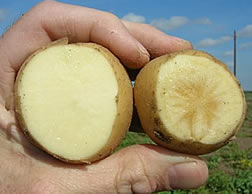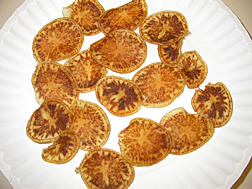This page has been archived and is being provided for reference purposes only. The page is no longer being updated, and therefore, links on the page may be invalid.
|
|
Researchers Build Case Against Insect as "Zebra Chip" Culprit
By Jan SuszkiwOctober 26, 2007
Tiny, cicadalike insects called psyllids are the prime suspects in Agricultural Research Service (ARS) investigations into the "zebra chip" disorder of potatoes.
Zebra chip (ZC) refers to dark, unsightly stripes that appear inside afflicted tubers, especially when cut and fried to make chips.
The disorder was first reported in Mexican potato fields in 1994 and in U.S. spuds in 2000 near Pearsall, Texas, and the Texas side of the Lower Rio Grande Valley. Outbreaks from 2004 to 2006 in Mexico, Texas and other U.S. states cost growers and processors on both sides of the border millions of dollars in losses.
The cause of ZC isn't known yet, but Jim Crosslin and Joseph Munyaneza's studies show a strong correlation to feeding by the psyllid species Bactericera cockerelli.
Crosslin, a plant pathologist in the ARS Vegetable and Forage Crops Research Unit, Prosser, Wash., and Munyaneza, an entomologist in the ARS Yakima Agricultural Research Laboratory, Wapato, Wash., consider B. cockerelli an "insect of interest" for several reasons: Potato plants are favorite hosts; its nymph stage injects toxins that cause psyllid yellows disease, whose symptoms resemble ZC's; it was prevalent in ZC-infested fields Munyaneza surveyed in south Texas in 2004; and it winters in the Lower Rio Grande Valley and migrates north in the spring.
In experiments, the researchers used two groups of potato plants—one with psyllids and one without. In greenhouse trials with psyllid-exposed plants, ZC symptoms appeared in nearly 26 percent of tubers and 60 percent of fried chips. In field trials, the percentages were 15 and 57 percent, respectively. Psyllid-free plants showed no symptoms.
Using genetic fingerprinting methods, the researchers also checked the plants for phytoplasmas that cause potato purple-top wilt syndrome (PPTWS), whose symptoms resemble ZC. The tests were negative, however, suggesting ZC wasn't associated with PPTWS or leafhoppers that transmit PPTWS.
Crosslin notes that monitoring psyllids and targeting them with sprays appears to be an effective prevention method. Indeed, a McAllen, Texas, associate told of reducing potato losses from several hundred acres in 2006 to 50 this year.
ARS is the U.S. Department of Agriculture's chief scientific research agency.


